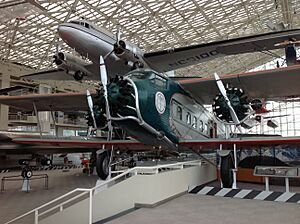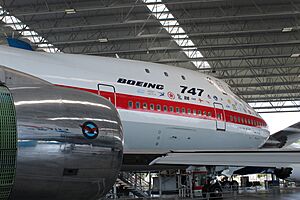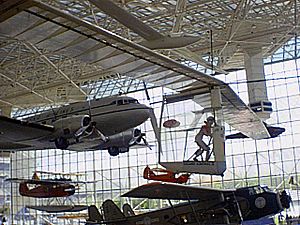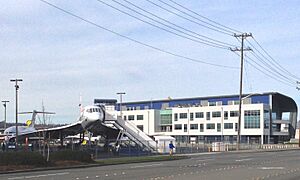Museum of Flight facts for kids
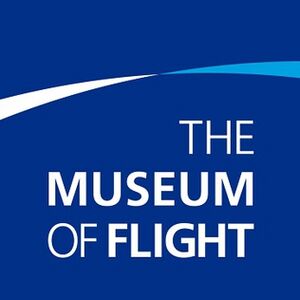 |
|

The museum's Great Gallery in 2005
|
|
| Former name | Pacific Museum of Flight |
|---|---|
| Established | 1965 |
| Location | King County International Airport (Boeing Field) 9404 E. Marginal Way Seattle, Washington, U.S. |
| Type | Aviation museum |
| Visitors | 500,000+ per year |
The Museum of Flight is a cool museum in the Seattle metropolitan area that's all about planes and space! It's a non-profit place, meaning it's not run for money.
It's located right next to Boeing Field (also known as King County International Airport) in Tukwila, Washington, just south of Seattle. The museum started in 1965 and is officially recognized by the American Alliance of Museums.
It's the biggest private air and space museum anywhere, and it has awesome learning programs for kids from kindergarten to high school. More than 500,000 people visit every year. The museum also helps over 140,000 students each year with programs like the Challenger Learning Center, an Aviation Learning Center, and a summer camp called ACE. They even have programs that travel across Washington and Oregon!
Contents
Museum History: How It Started
The Museum of Flight began with a group called the Pacific Northwest Aviation Historical Foundation in 1965. Their first big project was to find and fix up a 1929 Boeing 80A-1 airplane. They found it in Anchorage, Alaska.
It took 16 years to restore this old plane! Once it was finished, it became a main display at the museum. In 1968, the name "Museum of Flight" was first used for a small building they rented at the Seattle Center. Soon, they started planning for a much bigger, permanent home.
The Historic Red Barn
In 1975, the museum bought the William E. Boeing Red Barn for just one dollar! This old wooden building, built in 1909, was the very first home of the Boeing company. It was moved by a barge two miles (3 km) up the Duwamish River to its current spot next to Boeing Field.
It took a while to raise money for the Red Barn's restoration. But finally, in 1983, the two-story Red Barn opened to the public. It's a registered historic site today.
Building the Great Gallery
After the Red Barn opened, a big fundraising effort began in 1983. The goal was to build the T.A. Wilson Great Gallery. In 1987, Vice President George Bush helped open the new gallery.
The Great Gallery is huge, with enough space to hold more than 20 hanging aircraft. Some of these planes, like a Douglas DC-3, weigh over nine tons!
Learning and Expanding
The museum's education programs grew a lot in 1992 with the creation of a Challenger Learning Center. This cool exhibit lets students pretend they are on a Space Shuttle mission. It has a pretend NASA mission control room and lots of space experiments.
In 1994, the museum added a cafe and a large meeting room, making the museum even bigger. Around this time, a very popular plane, the Lockheed M-21, was put on display in the Great Gallery. This special plane was designed to carry Lockheed D-21 spy drones.
Air Force One and Air Traffic Control
In 1996, the first jet-powered Air Force One plane (a Boeing VC-137B) arrived at Boeing Field. This plane served presidents from 1959 to 1996. It's now on loan from the Air Force Museum and you can walk through it in the museum's Aviation Pavilion.
In 1997, the museum opened an interactive Air Traffic Control tower exhibit. It overlooks the busy runways of Boeing Field. This exhibit lets you see what it's like to be an air traffic controller.
Personal Courage Wing
A major new part of the museum opened in 2004: the J. Elroy McCaw Personal Courage Wing. This wing is named after a businessman and World War II veteran. It has two floors with over 25 World War I and World War II aircraft from many countries. It also has a huge collection of model planes from both wars. This wing opened on June 6, the 60th anniversary of D-Day.
Space Gallery and Shuttle Trainer
In 2010, the museum started building a new $12 million building called the Charles Simonyi Space Gallery. They hoped to get a real Space Shuttle from NASA. The new building has exhibits that tell the stories of people who designed, flew, and worked on the Space Shuttle and other space missions. This gallery opened in November 2012.
Even though the museum didn't get a real Space Shuttle, they did get the Full Fuselage Trainer (FFT). This is a life-sized model of a Shuttle that all Space Shuttle astronauts used for training! You can even take special guided tours inside it for an extra fee. The FFT started arriving in pieces in 2012.
In 2019, for the 50th anniversary of Apollo 11, the museum hosted a special exhibit. It featured the Apollo Command module Columbia, which was used during the first Moon landing!
Amazing Aircraft on Display
The Museum of Flight has more than 150 aircraft in its collection! Here are some of the most famous ones:
- Boeing 747: This is the very first 747 ever built that could fly! Its name is City of Everett. It first flew on February 9, 1969, and retired in 1990. You can walk through it!
- Boeing VC-137B SAM 970: This was the first presidential jet. It served presidents from 1959 to 1996. You can walk through this one too!
- Concorde 214: This is a super-fast British Airways Concorde jet. It's one of only four Concordes on display outside of Europe. You can walk through it!
- Caproni Ca.20: This is the world's first fighter plane from World War I. The one at the museum is the only one ever built!
- de Havilland Comet: This was the world's first jet airliner. It first flew in 1949. This plane is currently being restored at another location.
- Lockheed Model 10-E Electra: This plane was carefully restored to look just like the aircraft Amelia Earhart was flying when she disappeared.
- Lockheed D-21: This is an unmanned spy drone, displayed on top of the M-21.
- Lockheed M-21: This is the only surviving M-21, a special version of the Lockheed A-12.
- Lockheed SR-71 Blackbird: You can see the cockpit section of this super-fast spy plane.
- Boeing 737: This is the very first prototype of the Boeing 737-100.
- Boeing 787 Dreamliner: This is the third prototype of the 787-8. You can walk through it!
- Lockheed Martin RQ-3 DarkStar: This is the second prototype of the DarkStar drone.
- MacCready Gossamer Albatross II: This is a special aircraft powered only by a human pedaling!
- Aerocar International's Aerocar: This is one of only five remaining Aerocars. It's a car that can have wings and a propeller attached to fly!
- Douglas DC-2: This is one of only two DC-2 planes left in the world that can still fly.
- Boeing 80A: This is the only surviving 80A, which was flown by Bob Reeve in Alaska.
- Boeing 727-100 (E1): This is the original prototype of the Boeing 727-100, which used to belong to United Airlines.
- Lockheed L-1049G Super Constellation: This large plane used to fly for Trans-Canada Air Lines. It's now on display at the museum's outdoor airpark.
Museum Exhibits and Areas
The museum has many cool exhibits and facilities to explore.
Personal Courage Wing
The Personal Courage Wing (PCW) has 28 World War I and World War II aircraft. These planes come from different countries, including Germany, Russia, and Japan.
The Red Barn: Boeing's First Home
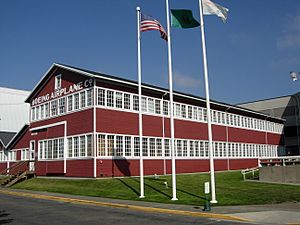
The "Red Barn" is a historic building, also known as Building No. 105. It was built in 1909 and was Boeing's first factory. Inside, you can see how wooden aircraft were made long ago. The exhibits show the history of aviation up to 1958.
Space: Exploring the New Frontier
In June 2007, the museum opened a new space exhibit called "Space: Exploring the New Frontier." This exhibit shows how space flight has changed over time, from early rockets to today's commercial space travel.
Restoration Center
The museum has a special restoration facility at Paine Field in Everett. Here, skilled workers and volunteers fix up old aircraft. They have about 39 projects going on, including a de Havilland Comet 4 jet airliner and a Boeing 2707 mockup.
Museum Library and Archives
The Harl V. Brackin Library at the Museum of Flight started in 1985. It has over 66,000 books and many magazines about aerospace and aviation. You can search their catalog online.
The Museum of Flight Archives is open to the public at the Kenneth H. Dahlberg Research Center. It holds millions of photos and many important documents. Some special collections include photos from Gordon S. Williams and Peter M. Bowers, and the archives of the American Fighter Aces Association. Since 2017, many of these materials are available to view online.
Other Cool Facilities
In September 2013, Raisbeck Aviation High School opened a new building right next to the museum. This school focuses on science, technology, engineering, and math with a special interest in aviation. The school works closely with the museum, Boeing, and other aviation companies. The museum also uses the school's facilities for its summer education programs.
The Aviation Pavilion opened to the public in June 2016. This huge covered area connects the high school and the Space Gallery. It allows large aircraft, like the B-17 Flying Fortress and B-29 Superfortress, to be on permanent display. The pavilion's roof is 140,000 square feet, which doubles the museum's exhibit space!
In May 2019, the museum opened the Vietnam Veterans' Memorial Park. This park features a fully restored B-52G Stratofortess called Midnight Express. The park is just west of the Aviation Pavilion and is free for everyone to visit.
See also
- List of aerospace museums


